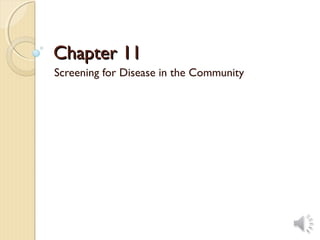
Screenings in the community
- 1. Chapter 11 Screening for Disease in the Community
- 2. Learning Objectives Define and discuss reliability and validity Define the term screening Define and discuss sensitivity and specificity
- 3. Screening for Disease Screening--the presumptive identification of unrecognized disease or defects by the application of tests, examinations, or other procedures that can be applied rapidly Positive screening results are followed by diagnostic tests to confirm actual disease
- 4. Multiphasic Screening Defined as the use of two or more screening tests together among large groups of people Information obtained on risk factor status, history of illness, and health measurements Commonly used by employers and health maintenance organizations
- 5. Mass Screening and Selective Screening Mass screening--screening on a large scale of total population groups regardless of risk status Selective screening--screens subsets of the population at high risk for disease ◦ More economical, and likely to yield more true cases.
- 6. Mass Health Examinations Population or epidemiologic surveys--purpose is to gain knowledge regarding the distribution and determinants of diseases in selected populations
- 7. Mass Health Examinations (cont’d) Epidemiologic surveillance--aims at the protection of community health through case detection and intervention Case finding (opportunistic screening)--the utilization of screening tests for detection of conditions unrelated to the patient’s chief complaint
- 8. Appropriate Situations for Screening Tests and Programs Social Scientific Ethical
- 9. Social The health problem should be important for the individual and the community Diagnostic follow-up and intervention should be available to all who require them There should be a favorable cost-benefit ratio Public acceptance must be high
- 10. Scientific Natural history of the condition should be adequately understood ◦ This knowledge permits identification of early stages of disease and appropriate biologic markers of progression Prevalence of the disease or condition is high
- 11. Ethical The program can alter the natural history of the condition in a significant proportion of those screened Suitable, acceptable tests for screening and diagnosis of the condition as well as acceptable, effective methods of prevention are available
- 12. Characteristics of a Good Screening Test Simple Rapid Inexpensive Safe Acceptable
- 13. Evaluation of Screening Tests Reliability types Validity types ◦ Repeated ◦ Content measurements ◦ Criterion- ◦ Internal consistency referenced ◦ Interrater Predictive Concurrent ◦ Construct
- 14. Reliability (Precision) The ability of a measuring instrument to give consistent results on repeated trials Repeated measurement reliability--the degree of consistency among repeated measurements of the same individual on more than one occasion
- 15. Reliability (cont’d) Internal consistency reliability--evaluates the degree of agreement or homogeneity within a questionnaire measure of an attitude, personal characteristic, or psychological attribute. Interrater reliability--reliability assessments derived from agreement among trained experts
- 16. Validity (Accuracy) The ability of a measuring instrument to give a true measure Can be evaluated only if an accepted and independent method for confirming the test measurement exists
- 17. Validity (cont’d) Content validity--the degree to which a measure covers the range of meanings included within the concept Criterion-referenced validity--found by correlating a measure with an external criterion of the entity being assessed
- 18. Validity (cont’d) Two types of criterion-referenced validity: ◦ Predictive validity--denotes the ability of a measure to predict some attribute or characteristic in the future ◦ Concurrent validity--obtained by correlating a measure with an alternative measure of the same phenomenon taken at the same point in time
- 19. Validity (cont’d) ConstructValidity--degree to which the measurement agrees with the theoretical concept being investigated
- 20. Interrelationships Between Reliability and Validity It is possible for a measure to be highly reliable but invalid It is not possible for a measure to be valid but unreliable
- 21. Representation of Reliability and Validity
- 22. Sources of Unreliability and Invalidity Measurement bias--constant errors that are introduced by a faulty measuring device and tend to reduce the reliability of measurements
- 23. Sources of Unreliability and Invalidity (cont’d) Halo effect--bias that affects the validity of questionnaire measurements
- 24. Example of Halo All items of a checklist evaluation of an employee may be filled out in the same general direction based on the supervisor’s opinion of the individual
- 25. Sources of Unreliability and Invalidity (cont’d) Social desirability effects ◦ Respondent answers questions in a manner that agrees with desirable social norms
- 26. Contingency (2 by 2)Table Disease Present Absent Total Screen Positive a b a+b Result Negative c d c+d Total a+c b+d
- 27. Sensitivity and Specificity Sensitivity = the probability that a person with the disease will test positive P(+ | D) Specificity = the probability that a person who does not have the disease will test negative 27
- 28. 28
- 29. Predictive Values Positive Predictive value = the probability that a person who tests positive has the disease Negative Predictive value = The probability that a person who tests negative does not have the disease 29
- 30. 30
- 31. 31
- 33. Effects of Disease Prevalence on the Predictive Value of a Screening Test When the prevalence of a disease falls, the predictive value (+) falls, and the predictive value (-) rises.
- 34. Relationship Between Sensitivity and Specificity To improve sensitivity, the cut point used to classify individuals as diseased should be moved farther in the range of the nondiseased (normals) To improve specificity, the cut point should be moved farther in the range typically associated with the disease
- 35. Relationship Between Sensitivity and Specificity (cont’d)
- 36. Procedures to Improve Sensitivity and Specificity Retrain screeners--reduces the amount of misclassification in tests that require human assessment Recalibrate screening instrument-- reduces the amount of imprecision Utilize a different test Utilize more than one test
- 37. Evaluation of Screening Programs Randomized control trials ◦ Subjects receive either the new screening test or usual care Case-control studies ◦ Cases--fatal cases of the disease ◦ Controls--nonfatal cases ◦ Exposure--screening program